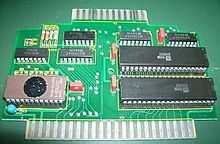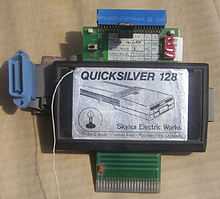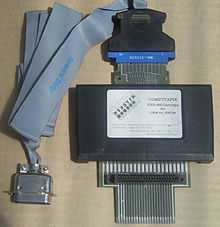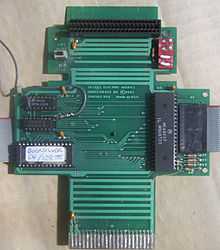Commodore D9060
The Commodore D9090 Hard Disk was the only family of hard drives that Commodore made for both the home and business market. The electronics are identical in the D9090 and the D9060 unit; the only difference is the size of the installed hard drive, with a jumper set to distinguish between 4 or 6 disk heads. Originally intended for the metal-cased PET series of computers, they were also usable with the Commodore 64 and later models with an adapter.
Technical data
| Model | Type | RPM | Heads | Actual | Formatted size | Blocks free | Free |
|---|---|---|---|---|---|---|---|
| D9090 | TANDON TM603S | 3,600 | 6 | 9.6 MB | 7.52 MB | 29,162 | 7290.5 kB |
| D9060 | TANDON TM602S | 3,600 | 4 | 6.4 MB | 5.01 MB | 19,442 | 4860.5 kB |
- on the D9090 25% of the hard disk is never used
Internally the system was made up of four major parts:
- CBM DOS 3.0 PCB
- SASI Controller
- Hard drive
- Power supply
Input voltage: 100, 117, 220, 240 V AC
Power supply
4-pin plug & cable - wiring and voltages follow world standard for large drive power cables, but colours are not standard.
| Pin | Usage |
|---|---|
| 1 | 5 V |
| 2 | Ground (black) |
| 3 | Ground (black) |
| 4 | 12 V |
CBM DOS 3.0 PCB
This DOS PCB is made up of several major electronic components:
- 3 x ROM's (Two for CBM DOS communication with host computer, One for SASI communications for Hard Drive formating- Track & Sector layout, 4 or 6 heads.)
- 4 or 6 heads is selectable only by a hardware jumper located on the front of the DOS PCB.
- 2 x MOS 6502 Microprocessors
- 2 x 6532 RIOT I/O Chip
- 1 x 6522 I/O chip
Disk system buffer = 4 kB (8 x 2114 SRAM chips) Commodore device number selectable between 8 - 11 (on IC 7H : 6532)
Connecting 2 hard drives to one (SASI) controller
Capable of managing 2 x MFM hard drive mechanisms, which is communicated to the user as two combined directories, with one header number = 0 and the other header number = 1 This is unlike other Commodore drives of this era, which required each separate disk directory to be called individually with a command LOAD"$",8,0 and LOAD"$",8,1 for the two drives that reside in device 8. It appears the DOS was never fully completed by Commodore; this is indicated by the way two directories overlap for the one device and the number of blocks free is displayed as if only one hard drive is in use.
SASI controller

The main brain driving this controller is the AMD 'AM2910' (a high-performance 8-bit slice microprogram sequencer) The SASI interface was invented by Shugart that became SEAGATE. SASI eventually became standardized and is known today as SCSI.
Hard drive

Internally the system had a transfer rate of 5.0 MB/s from the hard drive to the CBM DOS 3.0 Controller PCB. TANDON became Western Digital (WD).
Cylinders = 153 (per hard disc) 6 head drive contains 3 x hard discs, 4 head drive contains 2 hard discs.
Sectors per Cylinder = 192 (D9090)
Sectors per Cylinder = 128 (D9060)
Sectors per track = 32
Bytes per sector = 256
IEEE 488 bus
[24 wire parallel cable] IEEE 488 (transfer rate 1.2 K per second from D9090/D9060 to Computer - 8 Data lines) D9090/D9060 Hard Drives can be daisy chained, the same as the Commodore serial bus used on the 1541, 1571, 1581 Family of floppy drives.
The D9090 & D9060 were designed for usage primarily on the Commodore PET Family of computers, but because these metal-cased family of machines were obsoleted by the VIC-20 and the Commodore 64. The greatest demand for these drives came from the biggest home computer user market in the world at the time, the Commodore 64 user. As a result, Several companies built interfaces that effectively give a VIC-20 and Commodore 64/128 an IEEE-488 Port. Commodore created a VIC-20 IEEE 488 cartridge with model number "VIC-1112".

The Commodore 64 IEEE-488 Cartridges were made by various companies, but Commodore themselves never made one for the Commodore 64/128 family.
| Quicksilver 64/128 by Skyles electric works | Computapix IEEE Cartridge | Technofor |
|---|---|---|
 Quicksilver-128+ |
 Computapix+ |
Technofor-IEEE488 |
| Quicksilver-64/128 v2 | C64-Plus | VC40 Cartridge |
 Quicksilver-128-PCB+ |
C64plus-IEEE488 |
 VC40 Cart |
Some other interfaces without pictures available:
- E-LINK Serial to IEEE Interface. (contains 65C02, 6522 and 4 kB ROM)
- Buscard II Interface. (contains a 6532, 6821 (PIA) and 8 kB ROM, and a 256 byte PROM)
- INTERPOD - An Interface box, that converts IEEE-488 to CBM (IEC) serial & RS-232 serial.
Commodore 64/128 usage
The D9090 & D9060 Hard Drive was highly sought after in the early 1980s by the huge number of people using the Commodore 64 and Commodore 128 who wanted to taste the luxury of having all their utilities and games in one place, and being able to load these files and games at high speed, with an overall loading speed 5 times faster than the standard drive that most people were using Commodore 1541 with "664 BLOCKS FREE" (166 kB). Where as a D9090 hard Drive has 29 162 BLOCKS FREE (7290 kB). Which is why many bulletin board systems (BBS) were set up using these hard drives because they could access information so fast and could hold so much information compared to the 1541 disk drive which could only access 170 kB on one side of one disk at one time. By the late 1980s, the Commodore 64 had obsoleted all other Commodore 8-bit machines mainly because of the sheer number of users world wide and also the market support from so many 3rd party software & hardware companies. As a result, the older IEEE-488 Disk Drives & Hard drives were being acquired by large numbers of C64 owners to connect to their computer using an IEEE-488 Interface. This has put pressure on the supply of these devices as nowadays they are wanted by both Commodore 64/128 users and also needed by people using the PET family of machines, that these drives were specifically designed for.
Partitions and sub directories
Due to the structure of the onboard DOS 3.0, there is only one main Partition which contains the directory and all the saved files. There are no sub directories so eventually you run in to trouble when you type LOAD"$",8 and LIST, the directory list fills the screen and then scrolls away. You can pause the directory listing as with any Commodore computer. But if you have scores or hundreds of files saved, then the user must wait some time until the entire directory listing has finished scrolling.
Price when new
The oldest pricing reference found for this article was titled "Commodore Price List 1-september 1983"
- D9060 Hard Disk Drive 5 Megabytes = $4648 (Australia), £1995 (UK)
- D9090 Hard Disk Drive 7.5 Megabytes = $5813 (Australia), £2495 (UK)
Internal explained
Any 4 or 6 head MFM drive mechanism can be used as a replacement mechanism.
Formatting
Despite the trifling storage space (by conventional standards) of these legacy hard drives, formatting either can require a fair amount of patience from the user:
- D9060 (4 heads) Formatting takes approximately 1 hour.
- D9090 (6 heads) Formatting takes approximately 1 hour and 20 minutes.
Software, drivers & Technical support
Commodore 64 based software for drive management, file transfers & repair diagnosis is available from the SPACE_TAXI website.
A software & cable combination exists which allows using a common x86 compatible PC as a Virtual IEEE-488 hard drive. See here: baltissen.org/htm/cbmhd.htm
References
1. The Commodore D9090/D9060 Users Guide.
2. The Commodore D9090/D9060 Workshop Repair manual.
| ||||||||||||||||||||